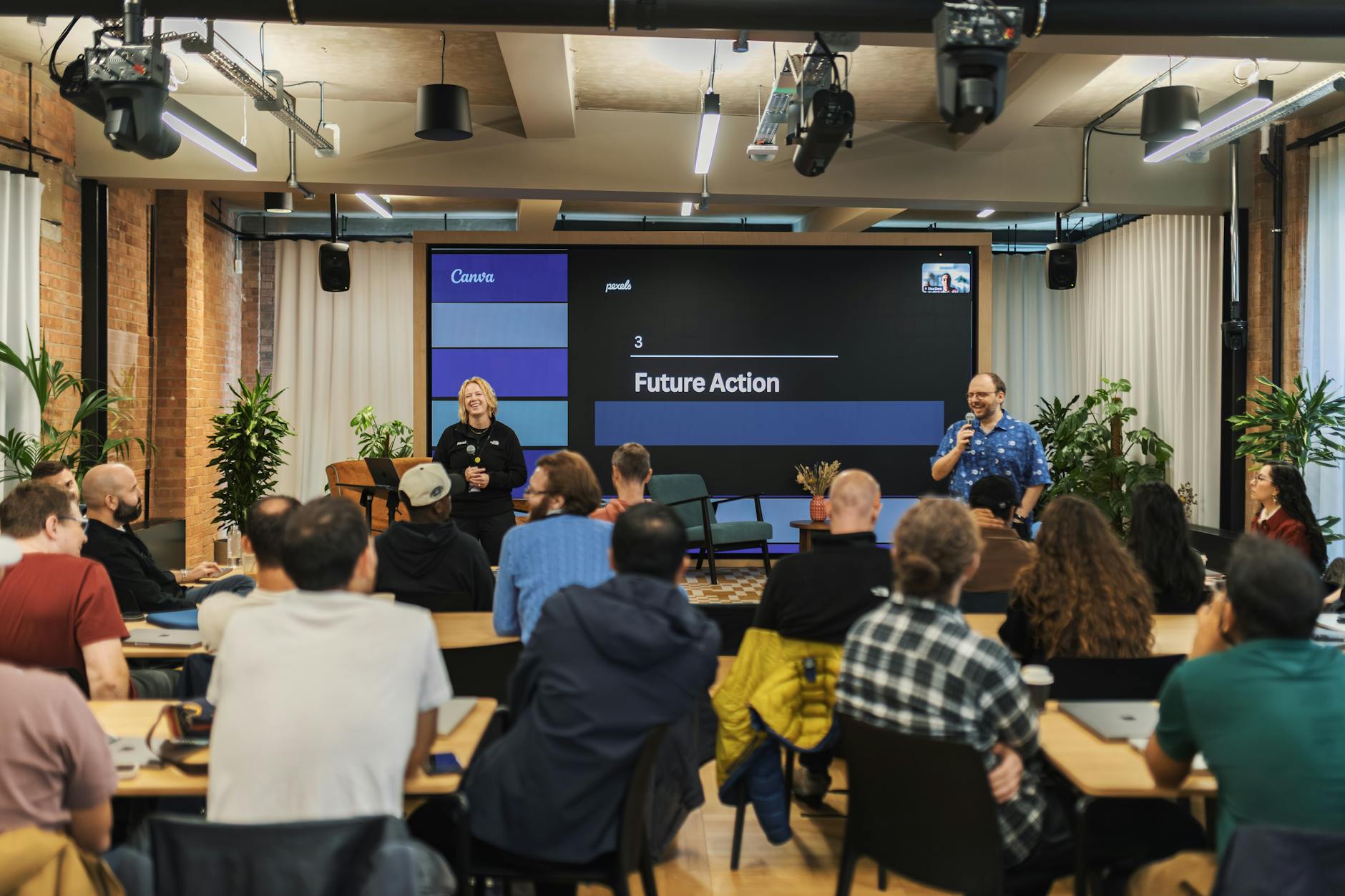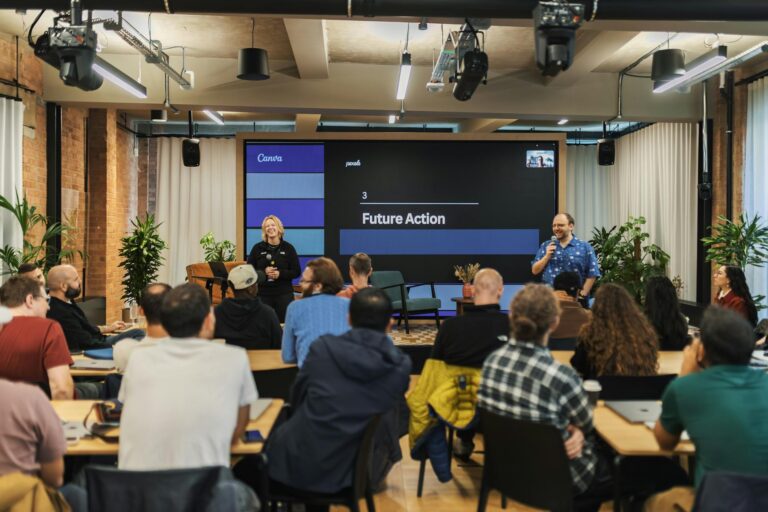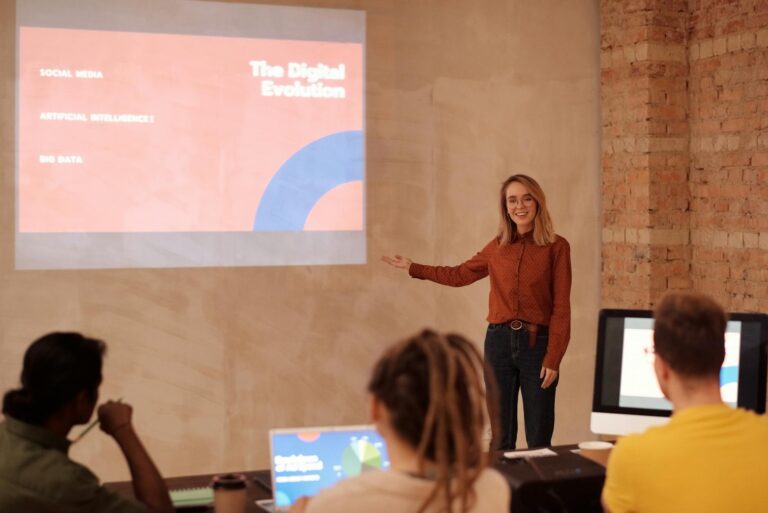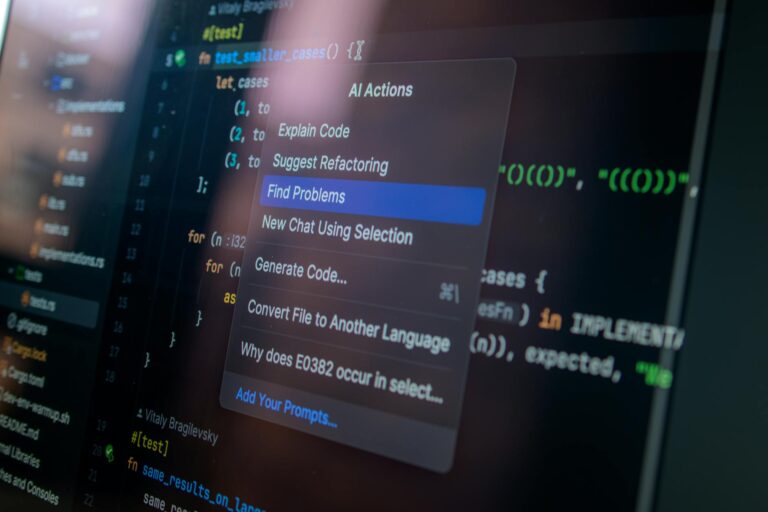Unlock 2025 Tech Trends for Business Growth
Navigating the Future: Unpacking Key 2025 Tech Trends for Business Growth
Estimated reading time: 10 minutes
Key Takeaways
- Prioritize speed and user experience in web development using frameworks like Next.js and headless CMS.
- Leverage cross-platform mobile frameworks (Flutter/React Native) for efficient app development and enhanced UI/UX.
- Adopt cloud computing, serverless architectures, and DevOps/CI/CD practices for scalable and agile operations.
- Integrate AI for automation, customer service chatbots, and innovative new business models.
- Focus on modern, accessible UI/UX design to create intuitive and inclusive digital products.
Table of Contents
- The Evolving Landscape of Web Development: Speed, Agility, and User Experience
- Mobile App Innovation: Cross-Platform Powerhouses and Enhanced Experiences
- Cloud Computing and DevOps: The Backbone of Modern Operations
- The AI Automation Revolution: Smarter Business, Not Harder Work
- Modern UI/UX Design: Crafting Seamless Digital Experiences
- Practical Takeaways for Your Business
- Leveraging These Trends with AITechScope: Your Partner in Digital Transformation
- Ready to Transform Your Business with 2025 Tech Trends?
The Evolving Landscape of Web Development: Speed, Agility, and User Experience
The digital landscape is a dynamic tapestry, constantly being rewoven by innovations that reshape how businesses operate, interact with customers, and drive growth. As we look ahead to 2025, a confluence of powerful 2025 tech trends is emerging, promising to redefine efficiency, enhance user experiences, and unlock unprecedented opportunities. For business professionals, entrepreneurs, and tech-forward leaders, understanding these shifts isn’t just about staying current; it’s about strategically positioning your organization for sustainable success in an increasingly digitized world.
From the lightning-fast performance of modern web applications to the intelligent automation powered by AI, and the seamless user experiences fostered by cutting-edge design, the technologies on the horizon are poised to become critical differentiators. This comprehensive guide will break down these pivotal trends, offering insights into how web development, mobile app innovation, cloud computing, DevOps practices, AI automation, and modern UI/UX design are converging to create a new paradigm for business. We’ll explore practical applications, delve into real-world benefits, and demonstrate how embracing these technologies can accelerate your digital transformation, optimize workflows, and ultimately, drive your business forward.
In today’s competitive digital arena, your website is often the first impression a potential customer has of your brand. Slow loading times, clunky interfaces, or outdated functionality are no longer mere inconveniences; they are significant barriers to conversion and customer retention. The 2025 tech trends in web development are heavily focused on addressing these challenges, prioritizing speed, developer agility, and an unparalleled user experience.
One of the most significant shifts is the continued dominance of modern frameworks like Next.js. For small businesses looking to establish a robust online presence quickly, Next.js offers an unparalleled solution. As highlighted by research, “Build a Fast Marketing Site in One Weekend” with Next.js, leveraging its server-side rendering and static site generation capabilities to deliver exceptional performance out of the box. This translates directly to better SEO, lower bounce rates, and a superior user journey from the moment they click. Beyond marketing sites, the focus on Next.js and React performance is paramount for any web application aiming to thrive. Simple React performance fixes, as detailed in various studies, can “Reduce Page Load by Seconds,” dramatically improving perceived speed and overall user satisfaction. Our own “Real-World Case Study” demonstrated how dedicated performance optimization could cut page load times by a staggering 60% for a client, directly impacting their bottom line through improved engagement.
Complementing these performance-driven frameworks is the growing adoption of headless CMS architectures. Traditional WordPress installations, while versatile, can sometimes suffer from bloat and performance bottlenecks. By moving to a headless setup, where the content management system is decoupled from the frontend presentation layer, businesses can gain immense flexibility. You can use “WordPress Without the Bloat” by selecting lightweight plugins that truly boost SEO, and then pair it with a modern frontend framework like Next.js. This approach offers the content authoring familiarity of WordPress while providing the speed, security, and scalability of a custom-built, modern application. This agility is crucial for adapting quickly to market demands and delivering personalized content across multiple channels.
For larger enterprises or complex web applications, micro frontends are gaining traction. This architectural style breaks down a monolithic frontend into smaller, independently deployable units, akin to microservices for the backend. While offering benefits in terms of team autonomy, scalability, and independent deployment cycles, it’s essential to understand “When They Help and When They Hurt.” Micro frontends can introduce complexity in orchestration and communication, making careful planning and a clear understanding of your organizational structure vital for successful implementation. However, when applied correctly, they can significantly accelerate development cycles for large-scale applications and allow for easier integration of diverse technologies and teams.
The overarching theme in web development for 2025 is clear: build fast, build smart, and build for the user. Technologies that empower developers to create highly performant, scalable, and maintainable applications will be at the forefront.
Mobile App Innovation: Cross-Platform Powerhouses and Enhanced Experiences
The mobile-first imperative continues to dominate, with users expecting seamless, high-performance applications on their smartphones. For businesses, the decision of how to develop mobile apps—native or cross-platform—is a critical strategic choice. The 2025 tech trends reveal a strong inclination towards cross-platform development, driven by efficiency, speed to market, and cost-effectiveness.
The perennial debate between Flutter vs React Native in 2025 remains a hot topic, but both frameworks continue to mature and offer compelling advantages for businesses. React Native, backed by Facebook, offers a JavaScript-based approach, leveraging a vast ecosystem and allowing web developers to transition relatively easily into mobile app development. Flutter, Google’s UI toolkit, emphasizes beautiful, natively compiled applications from a single codebase, delivering exceptional performance and a highly customizable UI.
For startups and small businesses, choosing “Which Is Best for Your Business App?” often boils down to existing team skill sets, project requirements, and the desired user experience. Both offer significant advantages over native development by allowing a single codebase to target both iOS and Android, drastically reducing development time and costs. This capability is paramount for rapid prototyping and deployment, allowing businesses to “Build a Simple Cross-Platform App with Flutter: From Idea to Play Store” with remarkable speed. This agility enables companies to validate ideas quickly, get feedback, and iterate without expending double the resources on separate native development efforts.
Beyond the frameworks themselves, mobile app UI trends are pushing towards more intuitive, responsive, and visually appealing designs. This includes the embrace of haptic feedback, dark mode integration, gesture-based navigation, and highly personalized user flows. The goal is to create immersive experiences that not only meet user expectations but exceed them, fostering loyalty and engagement. The focus on responsive UI design is no longer just about adapting to screen sizes but about creating fluid, adaptive experiences across a diverse range of devices and contexts.
Cloud Computing and DevOps: The Backbone of Modern Operations
Underpinning much of the innovation in web and mobile development is a robust and agile infrastructure. Cloud computing and DevOps practices are no longer emerging concepts; they are the fundamental pillars of modern IT, crucial for scalability, reliability, and speed in software delivery. The 2025 tech trends emphasize strategic cloud adoption, intelligent architecture, and continuous delivery.
For many businesses, particularly those with legacy systems, the journey to the cloud can seem daunting. However, it’s a necessary step for future-proofing operations. The guide on “How to Move Your Legacy App to the Cloud Without Breaking It” highlights a crucial aspect: careful planning, phased migration strategies, and selecting the right cloud environment are paramount. This often involves re-platforming, re-hosting, or even refactoring applications to fully leverage cloud-native services. The benefits—reduced infrastructure costs, enhanced scalability, improved disaster recovery, and global reach—far outweigh the initial migration challenges. A well-executed cloud migration strategy is a cornerstone of any successful digital transformation.
Central to cloud efficiency and scalability is serverless architecture. This paradigm allows developers to build and run applications without managing servers, abstracting away the operational overhead. As detailed in resources like “Serverless on AWS: Create a Cost-Efficient Backend That Scales Automatically,” serverless functions (like AWS Lambda) automatically scale with demand, and you only pay for the compute time consumed. This translates into significant cost savings, especially for applications with fluctuating traffic, and allows development teams to focus purely on code rather than infrastructure management. This “serverless AWS cost example” underscores its efficiency for startups and established businesses alike seeking a “serverless backend for startups.”
Complementing cloud infrastructure is the widespread adoption of DevOps best practices and CI/CD automation. Continuous Integration/Continuous Delivery (CI/CD) pipelines automate the process of building, testing, and deploying software, dramatically accelerating release cycles and reducing human error. For “CI/CD for Small Teams,” automated deployments can be achieved “Without the Headache” by leveraging tools like GitHub Actions. This allows even small development teams to implement robust, enterprise-grade deployment practices, ensuring faster time-to-market for new features and bug fixes. The automation inherent in CI/CD is a critical enabler for agility, quality, and responsiveness in a fast-paced market.
The move towards microservices architecture also continues to gain momentum within cloud and DevOps contexts. Breaking down applications into smaller, independent services allows for greater flexibility in technology choices, easier scaling of individual components, and improved fault isolation. While introducing complexities in distributed systems, when properly managed, microservices can significantly enhance an organization’s ability to innovate and adapt.
The AI Automation Revolution: Smarter Business, Not Harder Work
Perhaps no other area is seeing as explosive growth and transformative potential as AI automation for businesses. Artificial intelligence is rapidly moving from theoretical concept to practical, everyday utility, fundamentally changing how tasks are performed, decisions are made, and customers are served. The 2025 tech trends indicate that AI will be embedded into nearly every aspect of business operations, driving efficiency and intelligence.
One of the most immediate and impactful applications of AI is in workflow automation tools. Research shows how readily available no-code tools, combined with AI, can “Automate Repetitive Tasks with No-Code Tools + AI (Save 5–10 Hours/Week).” This is not about replacing human workers but empowering them to focus on higher-value, strategic activities. From automating data entry and report generation to streamlining onboarding processes and customer support routing, AI-powered automation frees up valuable human capital and significantly reduces operational costs.
AI chatbots for customer service are also evolving beyond basic FAQs to become sophisticated virtual assistants. “How Small Businesses Use Chatbots to Save Time” reveals real-world workflows where AI-powered conversational agents handle initial customer inquiries, qualify leads, provide instant support, and even complete transactions. This not only improves customer satisfaction through 24/7 availability but also drastically reduces the load on human customer service teams, allowing them to focus on complex issues. These intelligent agents are increasingly integrated into AI-powered web apps to provide personalized experiences.
Beyond customer service, AI is enabling “3 Low-Effort AI Features That Delight Users” in SaaS products, such as intelligent recommendations, personalized content feeds, and smart search capabilities. These AI-driven enhancements subtly improve user engagement and product stickiness, making services more intuitive and valuable.
Perhaps one of the most exciting developments demonstrating AI’s creative and practical power comes from ElevenLabs. This voice AI company is now “letting authors create and publish audiobooks on its own platform” using AI-generated narration. This breakthrough illustrates how AI is not just optimizing existing processes but creating entirely new business models and content formats. The ability to transform text into high-quality, expressive audiobooks quickly and at scale opens up new avenues for content creators and publishers, making knowledge and stories more accessible than ever before. This concrete example highlights the immense potential of AI-powered web apps and intelligent content creation.
Modern UI/UX Design: Crafting Seamless Digital Experiences
While powerful backend systems and cutting-edge AI drive functionality, it’s the user interface (UI) and user experience (UX) that ultimately determine adoption and satisfaction. Modern UI/UX design is evolving beyond aesthetics, focusing on intuition, accessibility, and delight. In 2025, a truly great digital product will be one that anticipates user needs, feels effortless, and is accessible to everyone.
The emphasis on responsive UI design is a given, ensuring applications adapt flawlessly across various devices and screen sizes. However, modern UX goes deeper, focusing on cognitive load, emotional response, and inclusive design principles. A crucial aspect often overlooked is accessibility. As detailed in “Designing Accessible Buttons: A Non-Designer’s Guide (Figma Tips),” even seemingly small design choices can have a profound impact on users with disabilities. By adhering to accessibility guidelines, businesses not only expand their potential customer base but also create a more robust and user-friendly experience for everyone. Inclusive design is no longer a niche consideration; it’s a fundamental requirement for ethical and successful digital products.
The goal of modern UI/UX is to create intuitive journeys that require minimal cognitive effort from the user. This involves clear information architecture, predictable navigation patterns, meaningful feedback mechanisms, and aesthetically pleasing interfaces that reinforce brand identity. Whether it’s mobile app UI trends or web application interfaces, the focus is on simplicity, clarity, and an almost invisible user experience where the technology fades into the background, allowing users to focus on their goals.
Practical Takeaways for Your Business
Navigating these 2025 tech trends might seem overwhelming, but integrating them into your business strategy is essential for staying competitive. Here are some practical steps you can take:
- Prioritize Performance: Invest in modern web development frameworks like Next.js and actively optimize your site’s performance. Fast-loading sites lead to better user engagement, higher conversions, and improved SEO.
- Embrace Automation: Identify repetitive, time-consuming tasks across your business operations. Explore AI-powered no-code tools and chatbot solutions to automate these workflows, freeing up your team for strategic work. Even “Digital Transformation on a Budget” can start with “7 Steps Small Companies Can Start Today,” focusing on automation and cloud adoption.
- Think Cross-Platform for Mobile: If a mobile app is on your roadmap, consider cross-platform frameworks like Flutter or React Native to accelerate development, reduce costs, and reach a wider audience with a single codebase.
- Strategic Cloud Adoption: Evaluate your existing infrastructure. Plan a thoughtful cloud migration strategy to leverage the scalability, cost-efficiency, and resilience of cloud services. Explore serverless architectures for new projects or specific functionalities to optimize operational costs.
- Implement DevOps: For any software development efforts, integrate CI/CD pipelines to streamline deployments, enhance collaboration, and ensure consistent quality. This is achievable even for small teams.
- Design for the User, Inclusively: Prioritize UI/UX design that is intuitive, aesthetically pleasing, and, crucially, accessible to all users. A delightful and inclusive user experience translates directly to customer loyalty and brand reputation.
- Explore AI for Innovation: Look beyond automation to see how AI can create new products, services, or improve existing ones, much like ElevenLabs is revolutionizing audiobook creation.
Leveraging These Trends with AITechScope: Your Partner in Digital Transformation
At AITechScope, we understand that capitalizing on these 2025 tech trends requires strategic insight, specialized expertise, and a partner who can translate complex technologies into tangible business value. We specialize in empowering businesses to thrive in this rapidly evolving digital landscape through intelligent delegation and advanced automation.
Our core offering revolves around AI-powered automation and virtual assistant services. We help businesses identify opportunities to automate repetitive tasks, streamline workflows, and reduce operational costs. Leveraging tools like n8n for workflow development, we can build sophisticated, intelligent automation solutions that integrate seamlessly with your existing systems, whether it’s customer service, data processing, or internal operations. Imagine freeing up your team to focus on innovation while our AI-driven solutions handle the routine.
Our AI consulting services are designed to guide you through the complexities of AI adoption. From strategy formulation to implementation, we help you understand how to integrate AI effectively, identify the most impactful applications for your specific business needs, and ensure a smooth transition. Whether you’re looking to implement AI chatbots for customer service, develop AI-powered web apps, or optimize your SaaS product with intelligent features, we provide the expertise to make it happen.
Furthermore, our proficiency extends to modern software development, including Next.js for small business site development, ensuring your online presence is fast, secure, and highly performant. We excel in website development with a focus on modern UI/UX design, creating intuitive and accessible digital experiences that resonate with your target audience. We also provide expertise in cloud migration strategy and DevOps best practices, helping you build a robust, scalable, and efficient infrastructure.
AITechScope is dedicated to helping businesses of all sizes scale operations, reduce costs, and improve efficiency through cutting-edge AI tools and technologies. We believe in the power of intelligent delegation to unlock growth and foster innovation. By partnering with us, you gain access to a team committed to transforming your digital strategy into a competitive advantage.
Ready to Transform Your Business with 2025 Tech Trends?
The future of business is digital, intelligent, and optimized. The 2025 tech trends we’ve explored present immense opportunities for growth, efficiency, and innovation. Don’t just observe the transformation; be a part of it.
Connect with AITechScope today to explore how our AI automation and consulting services, n8n workflow development, and web solutions can help you leverage these powerful technologies to scale your operations, reduce costs, and achieve unparalleled business efficiency. Let us be your trusted guide in navigating the exciting world of artificial intelligence and digital transformation.
FAQ
- What are the key web development trends for 2025?
- How can AI automation benefit my business?
- Why is modern UI/UX design important?
- What are the advantages of cross-platform mobile app development?
- How can cloud computing and DevOps improve business operations?
Key web development trends for 2025 include the continued dominance of modern frameworks like Next.js for speed and performance, the adoption of headless CMS architectures for flexibility and decoupling content, and the use of micro frontends for large-scale application development, all focused on speed, agility, and an unparalleled user experience.
AI automation can significantly benefit businesses by automating repetitive tasks, saving time, and reducing operational costs. This includes workflow automation tools, sophisticated AI chatbots for enhanced customer service, and the integration of AI-powered features in web applications to delight users and create new business models, such as AI-generated audiobooks.
Modern UI/UX design is crucial because it directly impacts user adoption and satisfaction. It focuses on creating intuitive, responsive, and aesthetically pleasing digital experiences that are also accessible to all users. A strong UI/UX reduces cognitive load, fosters customer loyalty, and reinforces brand identity across various devices and contexts.
Cross-platform mobile app development, using frameworks like Flutter or React Native, offers advantages such as efficiency, speed to market, and cost-effectiveness. It allows businesses to use a single codebase to target both iOS and Android platforms, drastically reducing development time, resources, and enabling rapid prototyping and deployment.
Cloud computing and DevOps improve business operations by providing a robust, scalable, and agile infrastructure. Cloud adoption offers reduced infrastructure costs, enhanced scalability, and improved disaster recovery. DevOps practices, especially CI/CD automation and serverless architectures, accelerate software delivery, reduce errors, and optimize operational costs, crucial for modern IT scalability and reliability.







